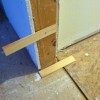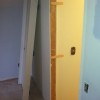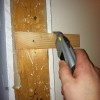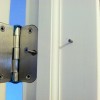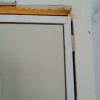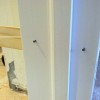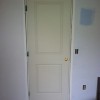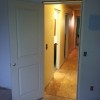How to Replace a Prehung Interior Door
Video
If your interior doors are severely stuck, rubbing, scratched, have holes, damaged beyond repair, or just don’t fit with your style, installing new prehung doors will sharpen the appearance of any room in your home and provide easy, daily operation. Installing a prehung door after removing an existing door isn't as difficult as you might think. With some patience and a little know-how, installing a prehung interior door is a project any DIY'er can do.
Selecting the Right Door
To start this project, measure your existing doors. Keep in mind that prehung doors are sold in standard sizes, and you should match your measurements with the nearest standard size. Determine the width of the door opening by measuring the space between the inside surfaces of the door jambs. Determine the height of the door opening by measuring from the bottom of the door to the inside edge of the top jamb. Measure the thickness of the door slab and the wall. You will also need to determine the swing of the door. Quick Tip: A simple way to do this is to stand in the doorway with your back to the hinged jamb. Cross your arms over your chest and swing your arm out parallel to the floor, along the path of the existing door swing. If it is your left arm that matches the existing door swing, it is a left-hand swing door; if it is your right arm, it is a right-hand swing door. After measuring and determining the swing of the door, consider the type, style, and hardware you'd like to have in your home. According to CostHelper.com, a new prehung door can cost anywhere from $25 – $900, depending on what type and style of door you choose.
How to Remove an Existing Door
Before installing your new prehung door, you should finish its surfaces. Depending on the type of material and your personal preference, the new prehung door should be finished with either a paint or stain. Once you have completed this step, you are ready to remove the existing door.
- Use a utility knife to cut a line in the 90?corner between the door casing and wall. This separates the paint and helps to ensure a clean removal of the door casing from the wall.
- Using a pry bar, gently remove the door casing from the wall.
- Unscrew the door hinges and remove the existing door slab from the door frame.
- Using a pry bar, separate the door frame from the rough opening lumber and remove it from the opening.
How to Install a Prehung Interior Door
Now you're ready to install the new prehung door. (Having done this a time or two before, I prefer to install prehung doors when it's time to replace the flooring. This allows me to work from a subfloor surface. The following steps should serve as a guide to properly installing a prehung door in this manner.) Any anomalies relating to the rough framing of your door opening or differences in flooring will require fewer or additional steps and/or modifications to the prehung door. You should also refer to the manufacturer’s installation instructions, which you can often find online should you fail to receive them with the new prehung door.
- Using a 4' level, ensure that the hinge-side trimmer (or jack) stud is vertically plumb. Tack tapered shims to the surface of the rough framing to create a vertically plumb surface from which to work.
- Position a tapered shim on the floor for the hinged jamb to rest on.
- Place the new prehung door, with the door slab attached to the hinges, in the opening. It is helpful to have an extra set of hands at this point to ensure that the door doesn't swing and twist the door frame.
- Align the outside face of the hinged jamb on both sides, ensuring that it is flush with the face of drywall on both sides.
- Secure the door frame with finish nails through the hinged jamb and tapered shims. Use two finish nails, one on either side of the door stop, near the location of the door hinges. With the 4' level, ensure that the jamb remains vertically plumb. Do not set the finish nails at this time.
- Remove the middle screw of the top hinge and replace with a 2" - 3" long screw. Be sure to not drive the screw in too far, as it may cause the door frame to draw inward toward the rough opening framing.
- Using a short level, ensure that the top jamb is horizontally level. Mark the location of the top edge, of a horizontally level top jamb, on the adjacent wall. (If you're installing a door simultaneously with replacing the flooring, this step will lift the latched jamb slightly off the subfloor surface, which is fine. We want the top jamb to be level and this space will disappear when the new flooring is laid.)
- Align the outside face of the latched jamb on both sides, ensuring that it is flush with the face of drywall on both sides.
- Align the top edge of the top jamb with the previously made mark. Place a tapered shim or two between the latched jamb and rough opening framing. Close the door and assess the gap between the door slab and the face of the door jamb. The gap should remain consistent around the door slab: up the hinged jamb, along the top jamb, and down the latched jamb.
- Secure the door frame with a finish nail through the latched jamb and tapered shim. Do not set the finish nails at this time.
- Using a 4' level and tapered shims, ensure the latched jamb is vertically plumb.
- Secure the remaining portion of the door frame with finish nails through the latched jamb and tapered shims. Do not set the finish nails at this time.
- Once again, close the door and assess the gap. It should be consistent from floor to top jamb on both sides and along the top of the door. Any inconsistency, where the jamb pinches toward the door, might be a location where the door could rub the frame in the future.
- Ensure that the door closes against the door stop. Adjustments may be necessary to the hinged or latched jambs and/or the door stop.
- Open the door halfway. You want to be sure that the door stays put and can come to a complete rest, without sway. If the door sways, the door frame is out of balance. Quick Tip: A door that sways open commonly indicates that the door is leaning toward the swing side; vice versa, a door that sways closed commonly indicates that the door is leaning toward the opposite side. Adjustments may be necessary to the hinged or latched jambs.
- Once you have ensured that the door can close to the door stop and come to a complete rest and you have noted the consistency of the gap around the door, you can set the finish nails, remove excess wood from the tapered shims with a handsaw or a utility knife, and install the remaining door hardware.
After installing the new prehung door you will want to putty the nail holes, touch up the paint or apply another coat of paint, and finish the opening with wood trim around the door. This type of wood trim is commonly referred to as door casing. It will conceal the void between the door frame and the rough opening framing and provide for a neat and finished appearance.

Jeff Calcamuggio
Jeff is an Editor-at-Large for Buildipedia.com who writes and edits Featured At Home and Knowledgebase content. Prior to joining Buildipedia, Jeff's work experience included carpentry, construction documentation, specification writing, construction administration, project management, and real estate property inspection. Jeff is a member of the Construction Specifications Institute (CSI) and an educator at Columbus State Community College and enjoys challenging DIY home improvement projects.


